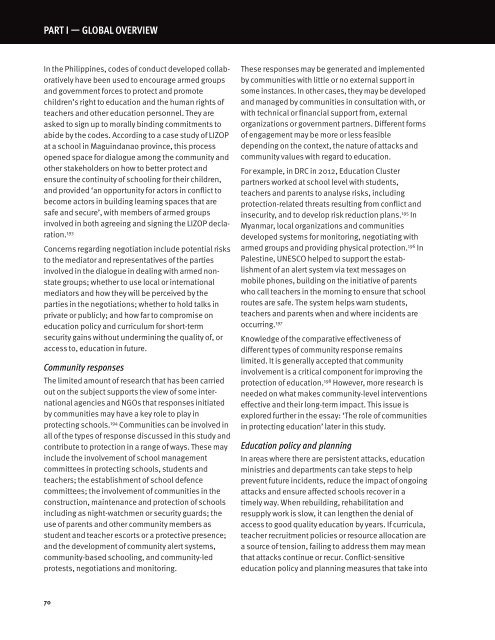Create successful ePaper yourself
Turn your PDF publications into a flip-book with our unique Google optimized e-Paper software.
PART I — GLOBAL OveRvIeW<br />
In the Philippines, codes of conduct developed collaboratively<br />
have been used to encourage armed groups<br />
and government forces to protect and promote<br />
children’s right to education and the human rights of<br />
teachers and other education personnel. They are<br />
asked to sign up to morally binding commitments to<br />
abide by the codes. According to a case study of LIZOP<br />
at a school in Maguindanao province, this process<br />
opened space for dialogue among the community and<br />
other stakeholders on how to better protect and<br />
ensure the continuity of schooling for their children,<br />
and provided ‘an opportunity for actors in conflict to<br />
become actors in building learning spaces that are<br />
safe and secure’, with members of armed groups<br />
involved in both agreeing and signing the LIZOP declaration.<br />
193<br />
Concerns regarding negotiation include potential risks<br />
to the mediator and representatives of the parties<br />
involved in the dialogue in dealing with armed nonstate<br />
groups; whether to use local or international<br />
mediators and how they will be perceived by the<br />
parties in the negotiations; whether to hold talks in<br />
private or publicly; and how far to compromise on<br />
education policy and curriculum for short-term<br />
security gains without undermining the quality of, or<br />
access to, education in future.<br />
Community responses<br />
The limited amount of research that has been carried<br />
out on the subject supports the view of some inter -<br />
national agencies and NGOs that responses initiated<br />
by communities may have a key role to play in<br />
protecting schools. 194 Communities can be involved in<br />
all of the types of response discussed in this study and<br />
contribute to protection in a range of ways. These may<br />
include the involvement of school management<br />
committees in protecting schools, students and<br />
teachers; the establishment of school defence<br />
committees; the involvement of communities in the<br />
construction, maintenance and protection of schools<br />
including as night-watchmen or security guards; the<br />
use of parents and other community members as<br />
student and teacher escorts or a protective presence;<br />
and the development of community alert systems,<br />
community-based schooling, and community-led<br />
protests, negotiations and monitoring.<br />
These responses may be generated and implemented<br />
by communities with little or no external support in<br />
some instances. In other cases, they may be developed<br />
and managed by communities in consultation with, or<br />
with technical or financial support from, external<br />
organizations or government partners. Different forms<br />
of engagement may be more or less feasible<br />
depending on the context, the nature of attacks and<br />
community values with regard to education.<br />
For example, in DRC in 2012, Education Cluster<br />
partners worked at school level with students,<br />
teachers and parents to analyse risks, including<br />
protection-related threats resulting from conflict and<br />
insecurity, and to develop risk reduction plans. 195 In<br />
Myanmar, local organizations and communities<br />
developed systems for monitoring, negotiating with<br />
armed groups and providing physical protection. 196 In<br />
Palestine, UNESCO helped to support the establishment<br />
of an alert system via text messages on<br />
mobile phones, building on the initiative of parents<br />
who call teachers in the morning to ensure that school<br />
routes are safe. The system helps warn students,<br />
teachers and parents when and where incidents are<br />
occurring. 197<br />
Knowledge of the comparative effectiveness of<br />
different types of community response remains<br />
limited. It is generally accepted that community<br />
involvement is a critical component for improving the<br />
protection of education. 198 However, more research is<br />
needed on what makes community-level interventions<br />
effective and their long-term impact. This issue is<br />
explored further in the essay: ‘The role of communities<br />
in protecting education’ later in this study.<br />
Education policy and planning<br />
In areas where there are persistent attacks, education<br />
ministries and departments can take steps to help<br />
prevent future incidents, reduce the impact of ongoing<br />
attacks and ensure affected schools recover in a<br />
timely way. When rebuilding, rehabilitation and<br />
resupply work is slow, it can lengthen the denial of<br />
access to good quality education by years. If curricula,<br />
teacher recruitment policies or resource allocation are<br />
a source of tension, failing to address them may mean<br />
that attacks continue or recur. Conflict-sensitive<br />
education policy and planning measures that take into<br />
70



